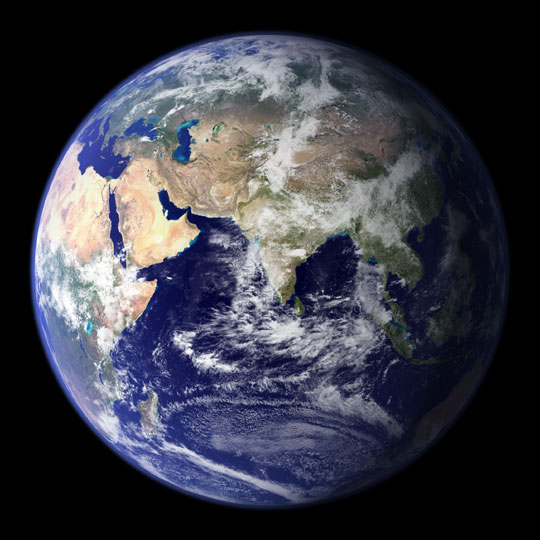Our Dynamic Earth: Climate Change
The Earth does move under our feet…
Geologists would be very surprised if we did not have a dynamic climate.
Visible Earth: Courtesy NASA Goddard Space Flight Center Image by Reto Stöckli (land surface, shallow water, clouds): Also see visibleearth.nasa.gov

Geologists have a different view of change and the dynamic forces that shape our planet by studying billions of years of history. Most processes that shape our earth take thousands or millions of years in order to see the effect. It is hard for the average person to understand that timeframe or to take seriously the importance of these changes. Think of the cutting of the Grand Canyon by a simple river. Of course there are earth occurrences that are quick. These include earthquakes, volcanic eruptions, flash flood, mud slides, etc. After any of these occurrences people are quite impressed with how our dynamic Earth “moves”.
The argument of Climate Change is also one of perceptions. Geologists are surprised that anyone would think that our climate would always be the same. There are periods in the geologic record (the analysis of the rocks and fossils that can tell us about our past) when it was colder and glaciers covered large portions of the earth OR hotter when most of our earth was very swampy. Our current oceans have not always existed as there were other oceans, in different locations in the past. Geologists would be very surprised if we didn’t have a dynamic climate.
So if we assume that we will experience climate change which has occurred during human history, the question becomes what causes the climate to change? This is where the geologic record is not precise enough to give us definitive answers. What we do know is that the earth’s temperature is a balancing act between energy entering and leaving the planet’s system. If the earth retains heat in the atmosphere or there are variations in the sun’s energy reaching earth or there are changes in the reflectivity of the earth’s atmosphere and surface then we can have an increase or decrease in temperature.
Are weather changes a precursor to climate change?
Are weather changes a precursor to climate change? We know that changing oceanographic currents and patterns can affect weather. Think about the impact of the El Nino/La Nina current on our own weather patterns in California. But how does weather change translate to permanent climate shifts? We don’t know.
Given that climate change is a natural phenomenon and occurs, for most people, the most important question concerning climate change is, how is or is man influencing climate change? If man is affecting climate change, what can we do to lessen that interference?
There are indications that man has impacted climate and contributed to a warming trend (Hegrel et al, 2007). The addition of manmade Greenhouse gases (carbon dioxide, methane, nitrous oxide, and fluorinated gases) has changed the earth’s temperature by increasing the amount of heat retained in earth’s atmosphere. Of course these compounds are also naturally found in nature. Since the Industrial Revolution began in around the 1750s, human activities have contributed by adding CO2 and other heat trapping gases to the atmosphere. Sources of these gases include changes in land use by man as well as burning fossil fuels. This is not all bad and has contributed to man as a species being successful, living longer, and increasing our standard of living.
So what do we know about our current shifting climate?
So what do we know about our current shifting climate? Temperature measurements around the world indicate that the earth’s overall temperature is increasing. This is reflected in sea levels around the world rising. It appears that glaciers are melting in some areas. The sea ice at the northern polar area is shrinking in size, forming later in the season and melting sooner. It appears that portions of the giant ice sheets in Antarctica are breaking up. What is less clear: does this mean we are going through a climate shift? Is our planet warming? If it is warming, is this harmful?
Clearly if the sea level is rising and you live on an island in Polynesia you would be worried. There have been instances of polar bears starving to death in the artic because of the change in the northern polar ice that has restricted their hunting patterns. In California, we have seen an increase in the range that insects and other pests have affected our agricultural industry. There can be positive inferences to a warming trend: perhaps some of the land mass in the northern hemisphere might be more habitable.
Can we stop a climate shift? Is it possible to remove the manmade element and let the climate change, or not, naturally?
Can we stop a climate shift? Is it possible to remove the manmade element and let the climate change, or not, naturally? Maybe or maybe not. Changing climate impacts society and ecosystems in a broad variety of ways. For example climate change can increase or decrease rainfall, influence agricultural crop yields, affect human health, cause changes to forests and other ecosystems, or even impact our energy supply. Climate-related impacts are occurring across regions of the US and across many sectors of our economy. Many state and local governments are already preparing for the impacts of climate change through “adaptation,” which is planning for the changes that are expected to occur. You can ask questions from your elected representatives. If there is a development close to the San Francisco Bay, have they considered rising sea levels? What about using energy efficiency products? How will climate change effect water use?
There are ways to reduce our carbon footprint and lessen the release of manmade greenhouse gases to the atmosphere. You can reduce emissions through simple actions such as using energy efficient appliances, managing the temperature of your environment, changing a light bulb, powering down electronics, using less water, reusing, and recycling. These are changes you can implement. Also, keep asking and learning about climate change.
References
Hegerl, G.C., F. W. Zwiers, P. Braconnot, N.P. Gillett, Y. Luo, J.A. Marengo Orsini, N. Nicholls, J.E. Penner and P.A. Stott (2007). Understanding and Attributing Climate Change. In: Climate Change 2007: The Physical Science Basis .Contribution of Working Group I to the Fourth Assessment Report of the Intergovernmental Panel on Climate Change [Solomon, S., D. Qin, M. Manning, Z. Chen, M. Marquis, K.B. Averyt, M. Tignor and H.L. Miller (eds.)]. Cambridge University Press, Cambridge, United Kingdom and New York, NY, USA.
Also see the other articles by Cecilia McCloy…
About the Author, Cecelia McCloy
a member of Peace
Cecelia McCloy is President and CEO of Integrated Science Solutions Inc. (ISSi). ISSi is a certified woman-owned science, technology, and engineering business that she started with her partner, David C. Dobson, PhD. Ms. McCloy manages engineering, environmental, information technology, and applied science programs for a variety of customers including NASA, EPA, national Laboratories (Lawrence Livermore, Lawrence Berkeley, and Sandia), DOE, DOD, and private clients.
Ms. McCloy is passionate about science, technology, engineering, and math (STEM) education, Small Business and Public Policy. She believes that increasing the number of STEM educated citizens married with an entrepreneurial spirit is key to keeping the US great. She was a speaker and participant at the Middle East and North Africa Businesswomen’s Summit Conference sponsored by the US State Department. She organized Public Policy Day for the National Association of Women Business Owners.
Ms. McCloy has been the subject of numerous articles, recipient of several awards, and volunteers for several nonprofits.
